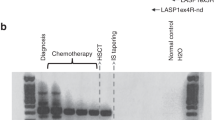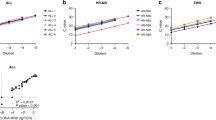Abstract
Reverse transcriptase polymerase chain reaction (RT-PCR) was applied to evaluate the frequency of tumour cells in PBPC products from 15 high risk Ewing tumour (ET) patients who were treated according to EICESS 92 with high-dose chemotherapy (HDC) and stem cell rescue. Initial tumour cell contamination of the bone marrow (BM) detected by light microscopy was found in five and by RT-PCR in eight cases. RT-PCR was performed on each PBPC sample repeatedly at a sensitivity comparable to 20–100 highly EWS-Fli1 expressing tumour cells per 10 ml of fresh blood. Irrespective of the extent of BM involvement at diagnosis, all BM samples obtained before harvest were RT-PCR negative. Among 12 of 35 analysed apheresis products with single positive RT-PCR results only one sample tested reproducibly positive for tumour cell contamination in independent determinations. These preliminary data suggest that tumour cell contamination of PBPC is rarely found in patients with ET.
This is a preview of subscription content, access via your institution
Access options
Subscribe to this journal
Receive 12 print issues and online access
$259.00 per year
only $21.58 per issue
Buy this article
- Purchase on Springer Link
- Instant access to full article PDF
Prices may be subject to local taxes which are calculated during checkout
Similar content being viewed by others
Author information
Authors and Affiliations
Rights and permissions
About this article
Cite this article
Fischmeister, G., Zoubek, A., Jugovic, D. et al. Low incidence of molecular evidence for tumour in PBPC harvests from patients with high risk Ewing tumours. Bone Marrow Transplant 24, 405–409 (1999). https://doi.org/10.1038/sj.bmt.1701924
Received:
Accepted:
Published:
Issue Date:
DOI: https://doi.org/10.1038/sj.bmt.1701924
Keywords
This article is cited by
-
Ewing Sarcoma tumor cells express CD34: implications for autologous stem cell transplantation
Bone Marrow Transplantation (2007)
-
Incidence and prognostic value of tumour cells detected by RT–PCR in peripheral blood stem cell collections from patients with Ewing tumour
British Journal of Cancer (2006)
-
High-dose chemotherapy and autologous peripheral blood stem cell transplantation in adult patients with high-risk or advanced Ewing and soft tissue sarcoma
Journal of Cancer Research and Clinical Oncology (2006)
-
High-dose chemotherapy and autologous peripheral blood stem-cell transfusion after conventional chemotherapy for patients with high-risk Ewing’s tumors
Journal of Orthopaedic Science (2002)
-
Transcription of Cytokeratins 8, 18, and 19 in Bone Marrow and Limited Expression of Cytokeratins 7 and 20 by Carcinoma Cells: Inherent Limitations for RT-PCR in the Detection of Isolated Tumor Cells
Laboratory Investigation (2001)



